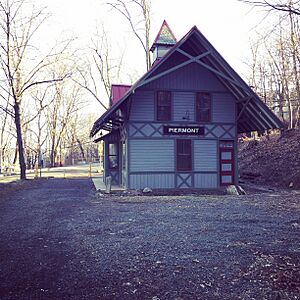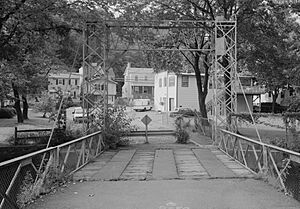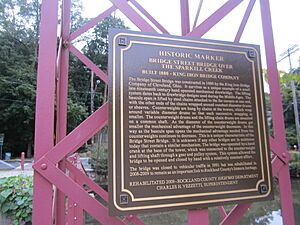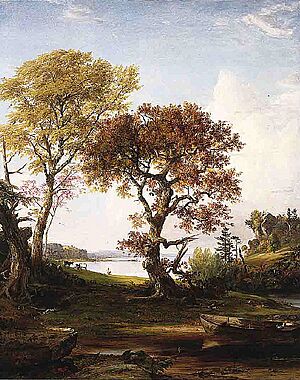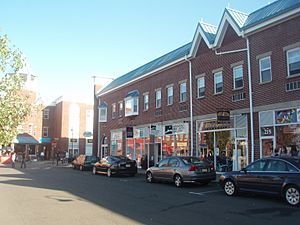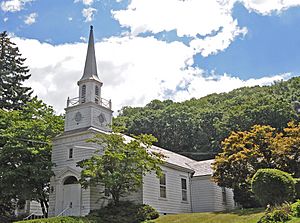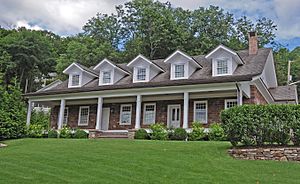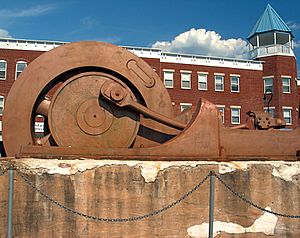Piermont, New York facts for kids
Quick facts for kids
Piermont, New York
|
|
|---|---|
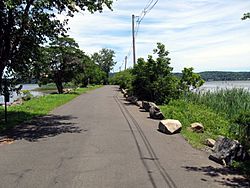
A short section of Piermont's long pier, the village's most prominent physical feature
|
|
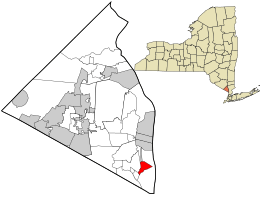
Location in Rockland County and the state of New York.
|
|
| Country | United States |
| State | New York |
| County | Rockland |
| Town | Orangetown |
| Incorporated | 1859 |
| Area | |
| • Total | 1.12 sq mi (2.89 km2) |
| • Land | 0.67 sq mi (1.74 km2) |
| • Water | 0.44 sq mi (1.15 km2) |
| Elevation | 95 ft (29 m) |
| Population
(2020)
|
|
| • Total | 2,517 |
| • Density | 3,739.97/sq mi (1,444.66/km2) |
| Time zone | UTC−5 (EST) |
| • Summer (DST) | UTC−4 (EDT) |
| ZIP Code |
10968
|
| Area code(s) | 845 |
| FIPS code | 36-57749 |
| GNIS feature ID | 960362 |
| Website | piermont-ny.org |
Piermont is a small village in Rockland County, New York. It is located on the west bank of the Hudson River. The village is part of the town of Orangetown. In 2020, about 2,517 people lived here.
The village was once called "Tappan Landing." Its current name, Piermont, was created by combining "Tallman Mountain" (a local mountain) and the "Erie Railroad pier" (a long dock). This name was given by Dr. Eleazar Lord, who was the first president of the Erie Railroad.
Contents
Exploring Piermont's Past: A Look at Its History
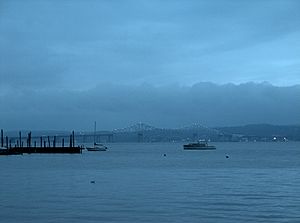
Piermont's location was very important for its early development. A creek called Sparkill Creek cuts through the Hudson Palisades. This made it easy to reach the fertile valley of the Hackensack River. Because of this, Piermont became a key port on the Hudson River.
The Erie Railroad built a long pier into the river in 1839. This pier was their main terminal, connecting train lines to New York City by water. The village was officially recognized in 1850.
During World War II, the pier played a special role. Soldiers from Camp Shanks would march to the pier. From there, they took ferries to other ports to travel overseas to the European Theater. A special plaque at the pier remembers this important history.
Today, Piermont is a popular spot for tourists from New York City. Many people, especially those riding bikes on Bike Route 9, enjoy visiting the village for a day.
The Piermont Pier: A Historic Landmark Faces Challenges
In November 2024, a part of the historic Piermont Pier was closed. This was because the concrete end of the pier was found to be unsafe. Experts said it was at risk of collapsing.
Mayor Bruce Tucker mentioned that a lot of money would be needed to fix it. He said, "We are going to need some major money here...if anyone has any money, we'd love to talk to them."
Piermont Station: A Glimpse into Rail History
Piermont had more than one train line serving the village. The Piermont Railroad Station is a beautiful building built in 1873. It is located on Ash Street. This station was a stop for the Erie Railroad's Northern Branch. This line ran from Nyack, New York, to Jersey City, New Jersey.
Train service through Piermont stopped in 1966. The line was later closed down in the 1970s. In 2006, the Piermont Historical Society restored the building. They made it look like it did originally, with its unique architecture and colors. The station was added to the National Register of Historic Places in 2006.
Piermont Fire Department: Protecting the Community
The Piermont Fire Department is a team of all-volunteer firefighters. They are located on Main Street. This department provides many important services. These include fighting fires, offering emergency medical services (EMS), and performing water rescues.
Piermont is one of the few places in Rockland County with a special Dive Rescue team. This team helps with water rescues from the Tappan Zee Bridge all the way to the Palisades.
The Unique Piermont Hand-Cranked Drawbridge
The Piermont hand-cranked drawbridge is also known as the Sparkill Creek Drawbridge. It was built in 1880 by the King Iron Bridge Company. This company built over 10,000 bridges!
This drawbridge is very special because it is hand-cranked. It might even be the only one like it in the United States. Today, it is used as a pedestrian walkway. It connects people to Tallman Mountain State Park.
In the past, fishermen would use this bridge. They would get out of their boats, crank up the bridge, sail across, and then crank it back down for cars. The bridge was taken apart and fully restored in 2009.
Piermont's Location and Landscape
Piermont is located at 41°2′26″N 73°55′8″W / 41.04056°N 73.91889°W.
The village covers about 1.1 square miles (2.89 square kilometers). About 0.7 square miles (1.74 square kilometers) of this is land. The rest, about 0.5 square miles (1.15 square kilometers), is water.
Piermont sits on the west bank of the Hudson River. It is just south of the Tappan Zee Bridge.
Who Lives in Piermont? A Look at the Population
| Historical population | |||
|---|---|---|---|
| Census | Pop. | %± | |
| 1870 | 1,703 | — | |
| 1880 | 1,369 | −19.6% | |
| 1890 | 1,219 | −11.0% | |
| 1900 | 1,153 | −5.4% | |
| 1910 | 1,380 | 19.7% | |
| 1920 | 1,600 | 15.9% | |
| 1930 | 1,765 | 10.3% | |
| 1940 | 1,876 | 6.3% | |
| 1950 | 1,897 | 1.1% | |
| 1960 | 1,906 | 0.5% | |
| 1970 | 2,386 | 25.2% | |
| 1980 | 2,269 | −4.9% | |
| 1990 | 2,163 | −4.7% | |
| 2000 | 2,607 | 20.5% | |
| 2010 | 2,510 | −3.7% | |
| 2020 | 2,517 | 0.3% | |
| U.S. Decennial Census | |||
According to the 2000 census, there were 2,607 people living in Piermont. There were 1,189 households and 672 families. The average household had about 2.19 people.
About 19.2% of the population was under 18 years old. The median age in the village was 40 years.
Famous Faces and Important People from Piermont
- Alfred Bristol was a World War II veteran from Piermont. He lived to be 100 years old! He served in a segregated Army unit. He received the Rockland County Buffalo Soldier Award. This award honors African-American military heroes. Bristol was part of the "Harlem Hellfighters" regiment. They fought in the Pacific during World War II. He also helped create the Tappan Public Library.
- William Gaddis was an American novelist. He lived in Piermont while writing some of his famous books.
- Mimi Bryan made history in 1974. She was elected Piermont's first woman mayor.
- John W. Ferdon was a politician from Piermont. He served in the United States House of Representatives and the New York State Assembly.
- Al Markim was an actor and producer. He was famous for playing Astro in the Tom Corbett, Space Cadet TV show.
Discovering Piermont: Places to Visit
Piermont has many interesting places to see and learn about.
Historical Markers: Stories from the Past
- Bogertown - Located at 102 Paradise Avenue.
- Sneden House - Found at 38 Paradise Avenue.
- Dederer Stone House or Stonehurst
Landmarks and Places of Interest: Explore Piermont
- Eleanor Stroud Park - This park has a pond next to Sparkill Creek. It's named after a woman who cared for children who ice skated there. She would serve them hot chocolate and snacks. The pond is free to use when a green flag is flying.
- William Ferdon House (on the National Register of Historic Places)
- First Reformed Church (on the National Register of Historic Places)
- Haddock's Hall - Located at 300 Ferdon Avenue (on the National Register of Historic Places).
- House at 352 Piermont Avenue (on the National Register of Historic Places).
- "Last Stop USA" memorial statue - This statue honors soldiers who died in World War II. The Piermont Pier was where many soldiers left for Europe.
- Onderdonk House - Located at 758 Piermont Avenue (on the National Register of Historic Places).
- Piermont Library
- Piermont Railroad Station - On Ash Street (on the National Register of Historic Places).
- The Piermont Historical Society

- Rockland Road Bridge - Between Piermont & Ferdon Avenue (on the National Register of Historic Places).
- Rockland Road Bridge Historic District (on the National Register of Historic Places).
- Sneden House - 38 Paradise Avenue.
- Sparkill Creek Drawbridge - On Bridge Street (on the National Register of Historic Places).
- Swamp Church - Carteret Avenue (St Charles A. M. E. Zion Church). This church was important to the local Black community in the 1800s.
Images for kids
See also
 In Spanish: Piermont (Nueva York) para niños
In Spanish: Piermont (Nueva York) para niños



